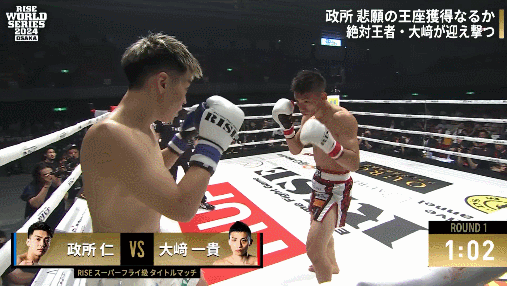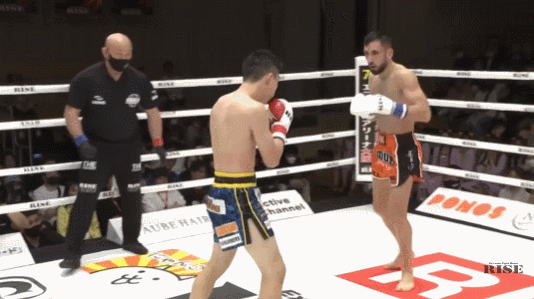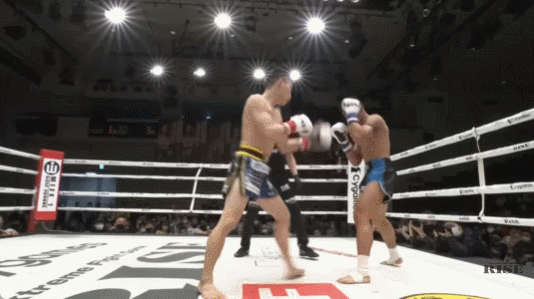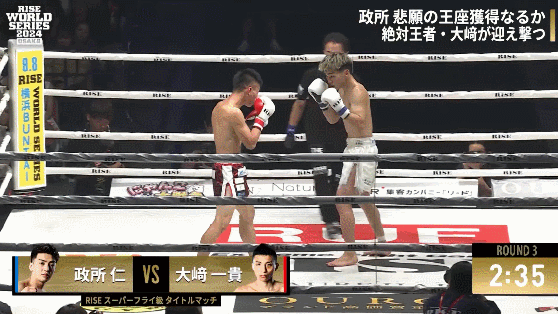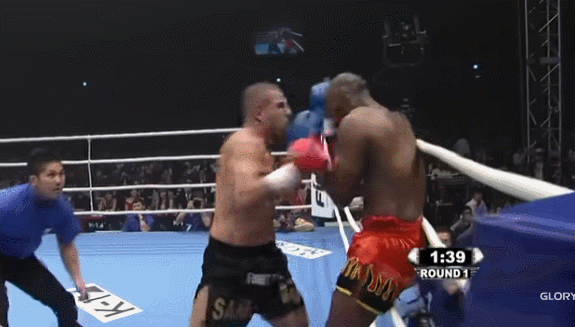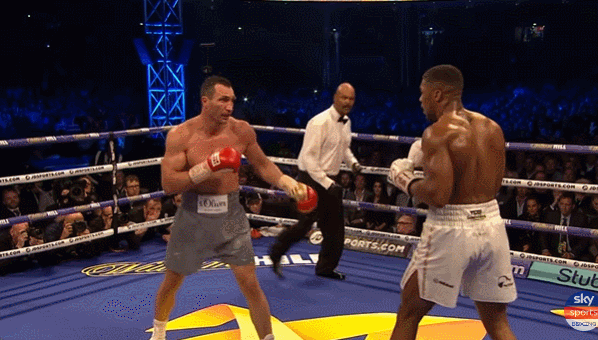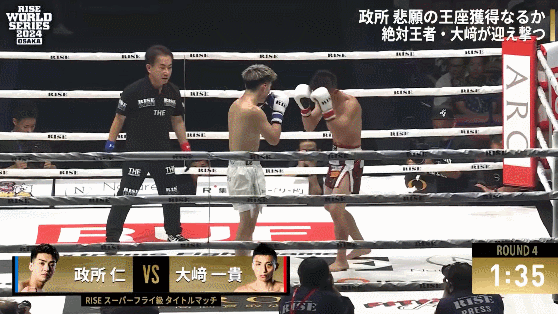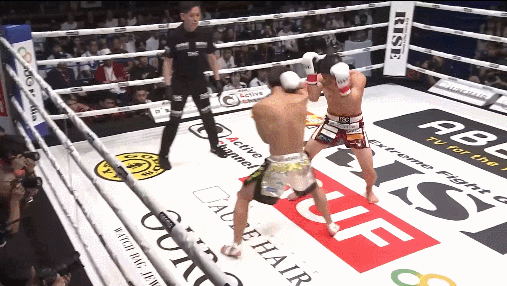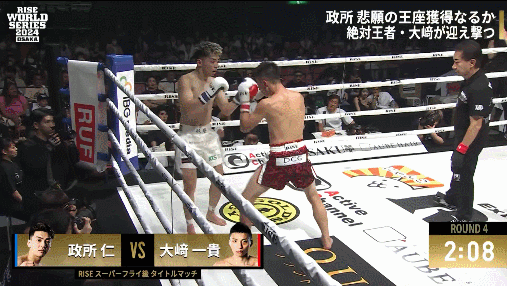Osaki vs Mandokoro –
Brazilian Low Kicks and Guard Manipulation
A couple of weeks ago, Kazuki Osaki defended his RISE Super Flyweight title against Jin Mandokoro. Osaki is a fighter we have given some attention in the past, I named him in my last Three Strikers You Should Be Studying article, and he has been a fixture of pound-for-pound rankings at both BeyondKick and Combat Press for a couple of years. Not only does he strike the beautiful middle-ground between constant aggression and technical proficiency, he shows it off every other month. In 2023, Osaki was able to fight six times and lost just once, in a -54kg tournament match against Toki Tamaru.
The Osaki – Mandokoro fight was compelling because Mandokoro attempted to use the same looks that Tamaru did, to stifle the offense of the tank-like Osaki. Osaki, however, was able to outbattle Mandokoro and take the five-round decision.
The fight is available in full on RISE’s excellent Youtube channel:
Digging Osaki Out of the Infight
Osaki’s up-and-down, two handed flurries require him to close the gap, and often take place along the ropes. To mitigate this Mandokoro, like others before him, attempted to use the stepping knee to dig Osaki out of inside position or intercept him coming in. In a fight with a reasonably large height disparity, the knee to head is almost always the exclusive property and advantage of the taller fighter and can be abused relentlessly.
Though Osaki is, of course, not unfamiliar with the opponent attempting to knee him. Most often he will mitigate the knee by momentarily abandoning his forward pressure to stand up straight or give ground. Against some opponents he will even use his elbows to spike the top of their thigh.
For this reason, Mandokoro was not able to land many knees, and while they would momentarily dissuade Osaki from closing the effect never lasted long and his confidence soon returned.
Mandokoro did snatch something out of the momentary pauses in Osaki’s pressure though. Checking both of Osaki’s hands as if to throw the knee, he would raise his leg, but turn it over into a low kick. Effectively a question mark kick or Brazilian kick delivered to a different target. A low kick from a high chamber is not going to do a lot of damage because you’re adding extra steps that hinder the mechanics used to create power—but the kick kept landing clean as Osaki faded back from the sight of the knee, and in a fight so close that multiple rounds were scored as 10-10s by the judges, point scoring matters.
Mandokoro’s other area of success was guard manipulation. Osaki is one of the best examples of the style of high guard that is sometimes called “crazy monkey.” That is to say that he does not simply cover up with his gloves high, but raises his elbows to spike or cushion against oncoming punches.
MMA fans might remember that Quinton ‘Rampage’ Jackson had a great deal of success with this method. In fact, before Jackson was known as a knockout puncher, he was very much a wrestler and ground and pounder. Like Dustin Poirier’s discovery of the shoulder roll, Jackson’s crazy monkey style cover ups accelerated his ability to develop as a striker because he became more comfortable under fire. In his first fight against Chuck Liddell, in the PRIDE Grand Prix, Jackson used the high elbows guard to catch and return against a striker who was supposed to be out of his league.
The obvious vulnerability is that the fighter eschews all guard for his body. This was true with Jackson—he was badly hurt with body work by Mauricio Rua, but of course his quick knockout against Chuck Liddell in their rematch came off Liddell throwing a body shot and having to stand close enough for the counter in order to do it. For his part, Kazuki Osaki does not let perfect be the enemy of good: his purpose is to close distance and do two handed hitting, and his high elbows guard allows him to do that even if he risks eating a few body shots.
Faced with this exaggerated high guard, the inside hand trap was Mandokoro’s weapon of choice. His left hand crossed Osaki’s centreline, attached to the inside of Osaki’s left wrist, and pulled it forward to create a clean line for Mandokoro’s right hand.
The inside hand trap is closely related to the cross hand trap. Cross hand traps are extremely common in kickboxing, and so popular among Dutch fighters that I previously referred to it as the “Dutch hand trap”. But it is normally performed on a covering opponent who is being overwhelmed. The fighter traces his hand over the top of his opponent’s head, before stripping the hand down from above. Here’s a clip of Gokhan Saki doing it.
The inside hand trap also involves crossing the centreline with your lead hand and opening yourself up a bit, but the opponent’s wrist is either pulled forwards or slapped outwards from the inside. You will most commonly see it against fighters who are standing with their lead hand quite extended in their guard anyway. Though Wladimir Klitshko had some lovely, fencing like tricks with his lead hand to get his opponents into position for this.
Mandokoro’s approach was a little different because Osaki was so often standing with his lead hand almost pressed against his forehead. Mandokoro shot his jab through the middle of Osaki’s guard, the vertical fist making this easier. Next he would jab down the left side of Osaki’s face and he would be able to strip the lead hand from the inside of Osaki’s guard.
It was likely Mandokoro’s plan to try to use his feet to stay off the ropes. Against the ropes Osaki is able to do his best two-handed flurrying. Most Osaki opponents try to avoid the boundary at all costs and few succeed. The notable standout in recent years was Toki Tamaru—himself one of the finest kickboxers in the world, pound-for-pound.
Tamaru maintained his stance well and pivoted out constantly, but he was aided by being a southpaw against the orthodox Osaki. Not only did stepping to the outside of Osaki’s lead foot and pivoting around him take Tamaru away from Osaki’s two-handed flurries, it took him away from the right low kick that Osaki is constantly attempting to time.
When Mandokoro attempted to step out to his left and pivot around the lead foot, he simply got hammered with the low kick, which buckled his leg in and kept him in place in front of Osaki for a follow up exchange.
When Mandokoro attempted to circle past Osaki’s lead foot—as Tamaru had done—he started too late, already along the ropes, his feet squared, and was already too close. Osaki was able to corral him with his left hook and flurry to a combination.
While the early going of the fight was hotly contested, Osaki was able to come on strong in the last two rounds while Mandokoro appeared to slow dramatically. Osaki confirmed that under 53kg he is still very much the man. Mandokoro, the up and comer, did not look at all out of place in a five round battle with one of kickboxing’s pound-for-pound stars. Yet there was no escaping that the dynamic of the fight was Osaki doing what he always does, and Mandokoro desperately trying to keep Osaki off him.


